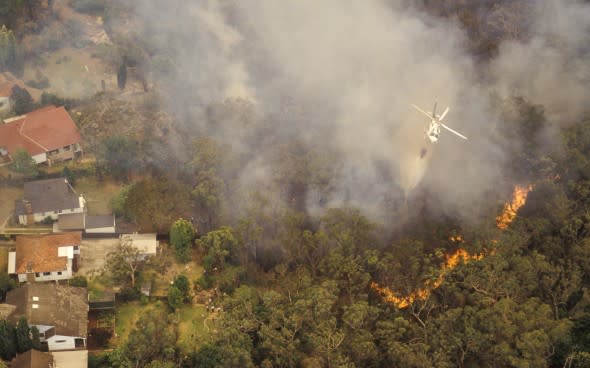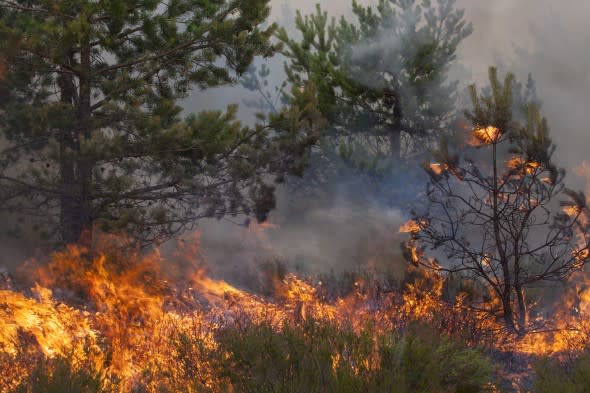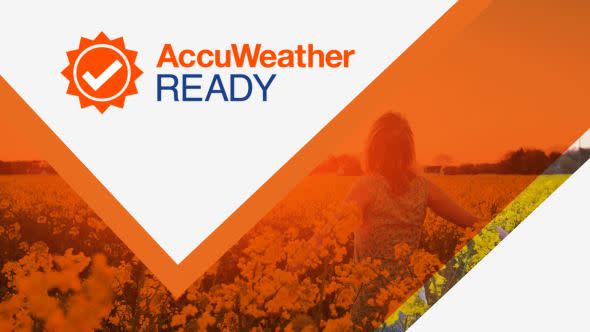How to prepare for wildfires so you can escape safely if a blaze approaches
Wildfires can ignite and spread suddenly, as high winds can fan flames, so being prepared to evacuate at a moment's notice could be the key to survival.
Experts said being prepared starts as soon as you build or buy a home. Evan Duffey, volunteer firefighter and AccuWeather meteorologist, said there are ways to make your home fire-safe before a wildfire starts.
"The main step is to create a buffer zone between your home and potential wildfire fuels," Duffey said. "When building a new home, intelligent selection of materials, especially roofing material, can help prevent your home from becoming part of the fire."

Aerial of water bombing a bush fire from a helicopter. (JohnCarnemolla/Getty Images/iStockphoto)
According to the Texas A&M Forest Service, Ready, Set, Go! program, if you live next to a dense vegetation area, you should create a buffer zone by removing weeds, brush and other vegetation. It is also a good idea to replace vegetation in these areas with rock or gravel. This helps to keep the fire away and reduces the risk of flying embers igniting.
Experts recommend buying a mask to keep smoke and harmful particles from causing respiratory issues, especially for those who suffer from respiratory illnesses. Early evacuation is also key to preventing the health hazards of inhaling smoke.
Before evacuating, take your emergency supply kit containing any necessary items for your family and pets. Most importantly, bring all of your documents such as passports and birth certificates.
If you have a fire-rated safe in your home, documents can be stored there instead. Those safes have multiple layers that act as an insulator, keeping heat from penetrating into the interior of the safe in case of a fire.
It's important to have plans ready since wildfires can strike with little notice and may require a fast evacuation.
"Meteorologists generally know when conditions are ripe for wildfires and how well a fire will spread once it has lit. However, it is more difficult to predict wildfire ignition," Duffey said.

Pine forest fire. (Viesinsh/Getty Images/iStockphoto)
Stacy Harvick, a wildland urban interface specialist with Texas A&M Forest Service, said there are a couple of indicators that can help you determine where fires will spread.
"A good rule of thumb is that the fire is going to be moving fastest in the direction that the wind is blowing," Harvick said.
However, wind is only part of the equation when it comes to determining fire growth. Terrain is another factor, as well as the time of day, Duffey said.
Experts say you should not wait to be advised to leave. Head to a predetermined location in a low-risk area, such as a well-prepared neighbor or relative's house, a Red Cross shelter, evacuation center or motel.
Once evacuation orders have been placed, the local police department will already be involved by helping residents follow the evacuation route.
"Our recommendation is to follow the evacuation route that has been set forth, by local officials," Harvick said.
It is important to keep batteries charged in order to stay up to date with local news and radio. By listening to local emergency management officials, you will know where the fire is spreading.
"When you make a household evacuation plan, it is smart to include the pets," Harvick said.
As for returning, monitor local news outlets for updates about lifted evacuations and road closures. Once the evacuation order is lifted, it is safe to return home.
"When you are allowed to reenter the area, you might still smell smoke without actually seeing any smoke or fire. When evacuations are lifted, the smoke levels are generally safe for the general public," Harvick said.
Texas A&M Forest Service has multiple programs that can help people prepare for wildfires. Ready, Set, Go! is a program to help people create an evacuation plan. Fire Wise is another program that can help homeowners prepare their homes and the area around their homes to have a better chance of surviving a wildfire.
For more safety and preparedness tips, visit AccuWeather.com/Ready.

